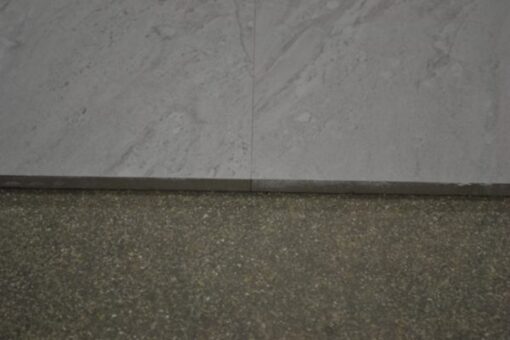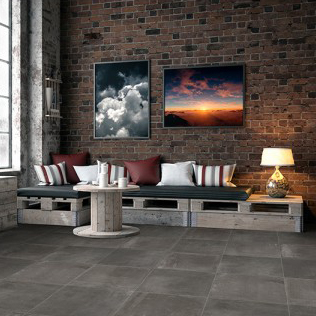
commercial blog
Let’s suppose that you really like two ceramic or porcelain tiles that look very similar. One tile is rectified; the other is not. How do you choose? In this article, we will clarify what the difference is between the two and why it matters to you for your tile installation.
Rectified Tiles
Rectified tiles are tiles that have been cut to an exact size meaning there is very little size variation between the individual tiles. As a result, there is less chance of lippage (vertical displacement), making for a more accurate layout and easy installation. With both large format tiles and narrower grout joints recently gaining popularity, rectification has become an important topic. Rectified tiles have their edges mechanically finished in order to achieve a more precise facial dimension, a process that involves cutting or grinding a tile to a specific size. Accurate and consistent tile sizes are particularly important with long and larger format tiles.
Below is an image that shows you two rectified tile pieces next to one another. Notice how clean, precise and exact the edges look:

Non-Rectified Tiles
A non-rectified tile has uneven edges. This makes for a more natural looking tile, but they require a wider grout joint, giving a more traditional tiled look. Choosing a rectified or non-rectified tile is down to preference and the type of space you are tiling.
Below is an image that shows you two non-rectified tile pieces next to one another:

How rectified tiles are made
Rectified tiles are first baked in sheets, then cut to size after coming out of the kiln. This is why it can be calibrated (dimensionally consistent) to exact specifications. Tiles can expand or contract after firing. Because rectified tiles are cut to size after firing and after they have cooled to normal operating temperatures, they are assured of being accurately sized. Rectified tiles can be installed with grout joints of 3mm or less. Most other tiles are first shaped and then baked afterwards in a kiln, so it often has as a greater difference in size between tiles in the same box.
The appeal of rectified tiles
Since they’re so even and uniform, when you’re working with rectified tiles, only the thinnest of grout lines is necessary. A thin grout line can give an almost seamless look with the right coloured grout and tiles, and it’s a fantastic effect when well executed. Because they’re so carefully produced, rectified tiles can be used to create a very clean, even and symmetrical look.
Are rectified tiles expensive?
Price is almost always relative to the quality, type and size of tile that you’re after, but rectified tiles usually cost more than non-rectified tiles of a similar standard, because there’s a bit more work that goes into producing them. Similarly, depending on the size of the grout line you’re after and where you’re laying them, you may also need to have them laid on a special bedding or substrate to ensure that they’re suitably flush.
How do you choose?
Rectification does not make a tile better or worse. Rectification simply affects the kind of edges the tile has which, in turn, means that rectified tile is ideal for specific types of tile installation. Talk to your installer before anything’s agreed upon, and make sure everyone’s clear about what’s required. The rectified tile design isn’t for everyone. However, if that’s the design inspiration you envisioned, you will definitely want to select the rectified tile version of the tile style you love.


blog, floors, walls

With the world becoming increasingly health conscious and equipped against germs, it’s important to consider all potentially harmful factors in your home to protect your family. Naturally, your flooring selection makes up a large portion of it. Rest assured, tiles are one of the most hygienic surfaces you could find!
Tiles are glass-like/ vitreous floors, making them an ideal wall and floor covering for places such as hospitals and commercial kitchens. They have a very low water absorption and are almost completely waterproof unlike other surfaces such as carpets, wood and even concrete. Naturally, water can contain viruses, bacteria, fungi, etc. The glass-like surface means virtually nothing can penetrate the surface and the low absorption rate means tiles do not absorb water, even from underneath.
Therefore, from a hygiene perspective, porcelain tiles (less than 0,5% water absorption) followed by glazed ceramic tiles (less than 3%) are the best. The key advantage of tiles is that they are quick and easy to clean as they can simply be disinfected and can withstand chemical and acids or alkalis. If you need advice on what to use to clean your tiles, check out our blog article called How To Clean Your Tiles.
The weak point, however, is in the tile grouting. Grout is more porous than tiles and is the inevitable starting point for fungal growth in particular. Grout, therefore, requires special attention; the fewer grout lines, the better. For this reason, large format tiles have become increasing popular as they require smaller grout lines.
A large format tile is considered to be square or rectangular in shape with the length of at least one edge greater than 600mm (nominal) or a facial area greater than 3500cm² (nominal). You can check out our range of large format tiles on our website. Interior designers love the near-seamless effect this creates, and they’ve made good use of these sophisticated tiles in hotels, restaurants and shopping malls. Sometimes, they use bold and dramatic large format tiles to really make a statement like these unique metallic bronze matt porcelain (600 x 1200 mm) tiles.

Since bacteria and fungi flourish in warm and wet conditions, bathrooms are particularly prone to these harmful germs. Ensure that wet areas in your home are dried/ ventilated after use to reduce the chances of germs flourishing and being spread.
Pop down to your nearest showroom to shop our range of beautiful porcelain and ceramic tiles.

how to articles

Tenting: the term used for the lifting of tiles.
Do you have whole floor tiles in your house that have suddenly started to crack? Cracked floor tiles can be an annoying eyesore and safety issue for many homeowners.
Whether your tiles are new or old there are many reasons why floor tiles can crack and most of them, are not because of the tile itself. We explore some of the reasons as to why this may occur.
Cause One: The concrete substrate didn’t cure for long enough
Newly poured concrete contains large amounts of water, as the concrete cures, the water evaporates and the concrete shrinks underneath the laid down tiles causing extra strain and pressure. New concrete should cure for a minimum of 28 days. Request that your tiler does a moisture test, this will tell you whether your tiles cracked due to the concrete or not.
Cause Two: The concrete substrate has cracked
While concrete seems to be a suitable base to lay tiles down, due to age, most concrete eventually cracks. When concrete substrate cracks underneath tiles, it is transmitted to the tiles and causes long, continuous reflective cracks that extend across multiple tiles. To prevent this situation from occurring, install a crack isolation membrane over the concrete during installation.
Cause Three: Hard, sharp knocks
If you have a crack that is only located and isolated to one area on one tile, then it is likely that something hard was dropped on the floor. This is especially common in areas such as the kitchen, where heavy objects, such as cans, pots or pans often get dropped. It is advisable to always buy 10% extra in spare tiles for your home. These occurrences are considered normal wear and tear.
Cause Four: A very heavy load
The breaking strength of a tile is regulated within the industry, and most tiles meet and exceed these standards. Commercial equipment, such as fridges, do not exert enough ground pressure to exceed the breaking strength of tiles. However, industrial machinery or commercial sliding security filling racks might be too heavy. Tiles are not the right flooring to use under industrial equipment.
Cause Five: Tiles installed over a concrete control joint
Control joints are essentially pre-planned cracks aimed at controlling where and in which direction the crack spreads. By catering for heat expansion and cold contraction of the concrete, this can usually be contained to a straight crack line. It is not good practice to use tiles to bridge a line that will knowingly expand in future.
Cause Six: Lifted tiles and cracks
Tenting, is the term used for the lifting of tiles, which is primarily caused by poor installation, improper use of adhesives or inadequate grouting and expansion joints at the edges of the room, room entrances or in very large or long rooms, such as passages. Due to lifting, this makes the tile more prone to cracking as it is no longer firmly bonded to the substrate. Furthermore, the force created from tiles expanding against each other may be enough to make a tile crack.
Cause Seven: Sub-standard tiles
While it is possible to buy sub-standard tiles, if you buy tiles from a respected professional supplier it is unlikely that this is the cause. However, ensure that the tiles that you have bought are compliant with ISO, ANSI or ASTM testing standards. You also need to ensure that the correct tiles have been used for the correct application.
For more tiling advice visit a Tiletoria near you today and speak to our friendly sales people before tiles start cracking up!
Tiletutorials with Tiletoria and KREM










